Analysis of Demand, Supply, and Policies in UK Private Housing Market
VerifiedAdded on 2023/01/18
|11
|3178
|81
Report
AI Summary
This report provides an in-depth analysis of the UK private housing market from an economic perspective. It begins with an introduction to business economics and its relevance to the housing sector. The main body delves into the factors that influence the demand and supply of private housing in the UK, utilizing demand and supply analysis to identify key determinants of price. These factors include stamp duty, interest rates, affordability, the cost of renting, and population changes. Furthermore, the report examines economic policies employed to stimulate demand within the private housing market, such as adjustments to interest rates and stamp duty. The analysis includes relevant graphs and data to support the discussion, offering a comprehensive overview of the market dynamics and policy impacts.
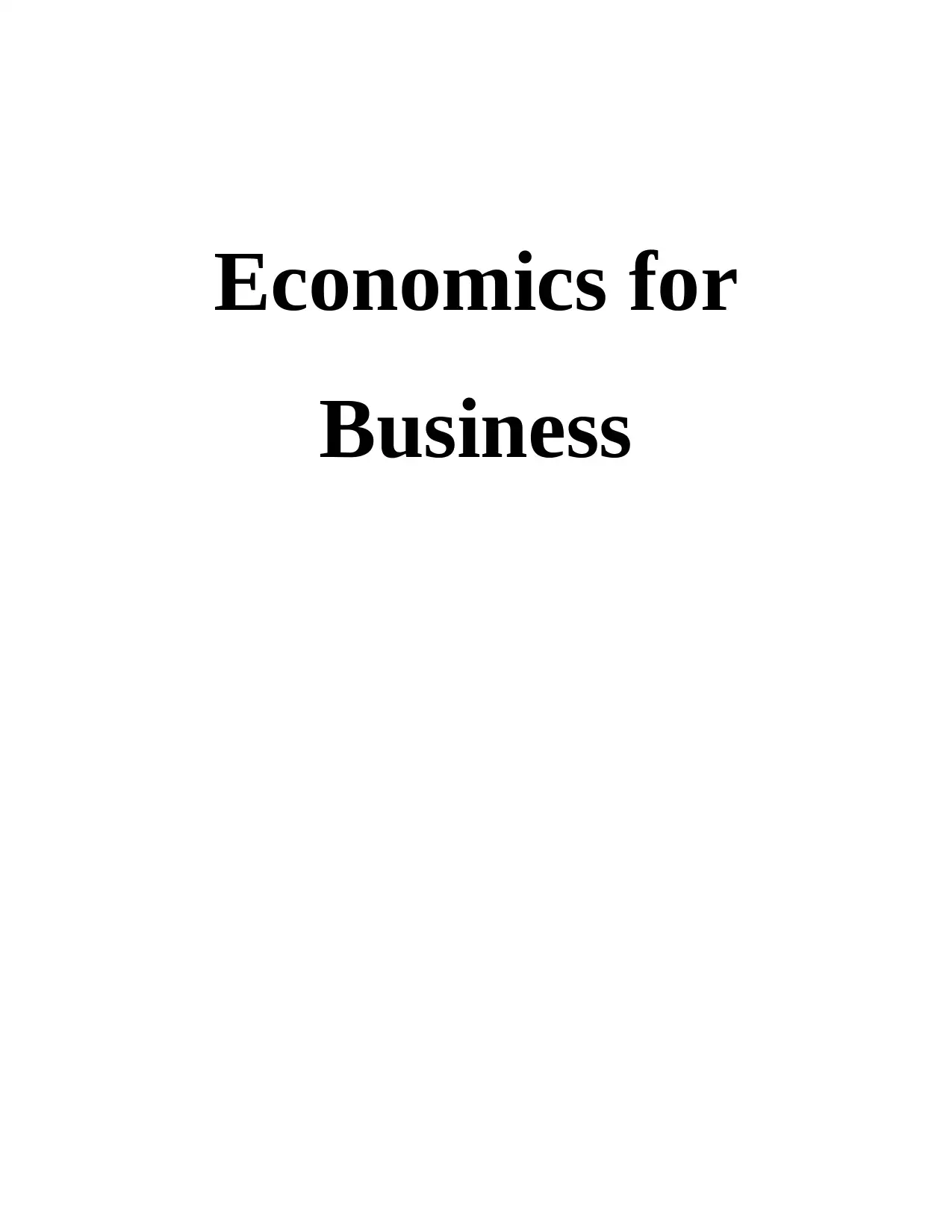
Economics for
Business
Business
Paraphrase This Document
Need a fresh take? Get an instant paraphrase of this document with our AI Paraphraser
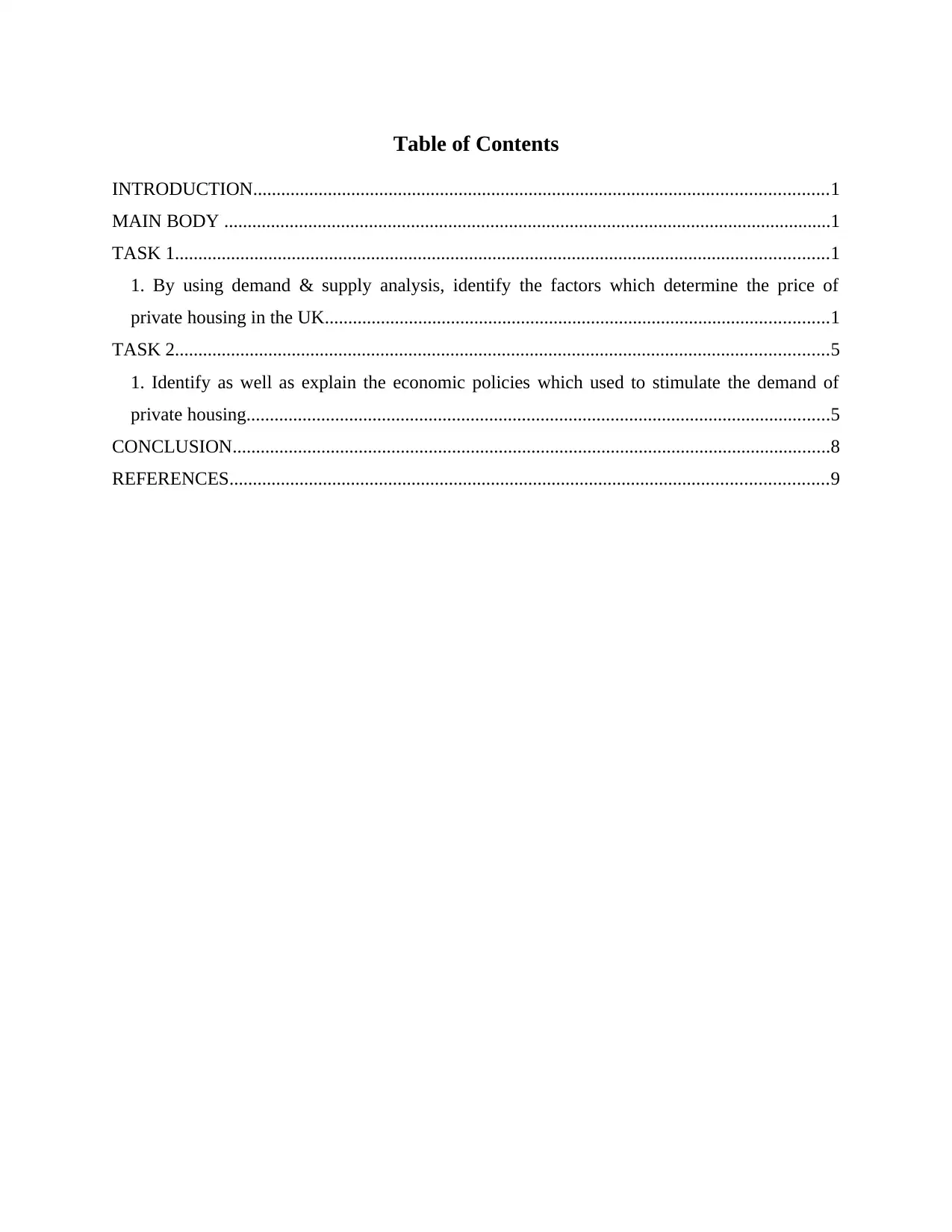
Table of Contents
INTRODUCTION...........................................................................................................................1
MAIN BODY ..................................................................................................................................1
TASK 1............................................................................................................................................1
1. By using demand & supply analysis, identify the factors which determine the price of
private housing in the UK............................................................................................................1
TASK 2............................................................................................................................................5
1. Identify as well as explain the economic policies which used to stimulate the demand of
private housing.............................................................................................................................5
CONCLUSION................................................................................................................................8
REFERENCES................................................................................................................................9
INTRODUCTION...........................................................................................................................1
MAIN BODY ..................................................................................................................................1
TASK 1............................................................................................................................................1
1. By using demand & supply analysis, identify the factors which determine the price of
private housing in the UK............................................................................................................1
TASK 2............................................................................................................................................5
1. Identify as well as explain the economic policies which used to stimulate the demand of
private housing.............................................................................................................................5
CONCLUSION................................................................................................................................8
REFERENCES................................................................................................................................9
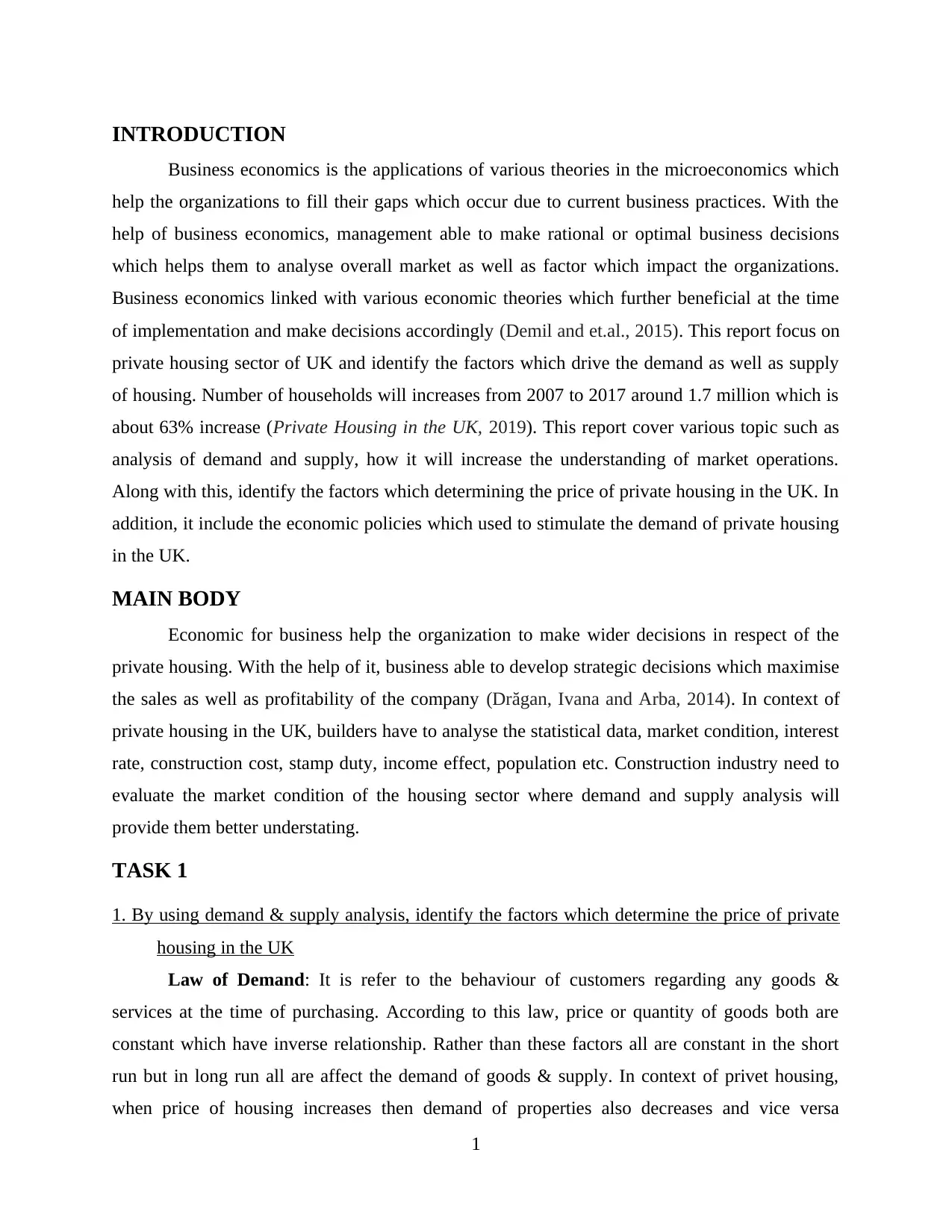
INTRODUCTION
Business economics is the applications of various theories in the microeconomics which
help the organizations to fill their gaps which occur due to current business practices. With the
help of business economics, management able to make rational or optimal business decisions
which helps them to analyse overall market as well as factor which impact the organizations.
Business economics linked with various economic theories which further beneficial at the time
of implementation and make decisions accordingly (Demil and et.al., 2015). This report focus on
private housing sector of UK and identify the factors which drive the demand as well as supply
of housing. Number of households will increases from 2007 to 2017 around 1.7 million which is
about 63% increase (Private Housing in the UK, 2019). This report cover various topic such as
analysis of demand and supply, how it will increase the understanding of market operations.
Along with this, identify the factors which determining the price of private housing in the UK. In
addition, it include the economic policies which used to stimulate the demand of private housing
in the UK.
MAIN BODY
Economic for business help the organization to make wider decisions in respect of the
private housing. With the help of it, business able to develop strategic decisions which maximise
the sales as well as profitability of the company (Drăgan, Ivana and Arba, 2014). In context of
private housing in the UK, builders have to analyse the statistical data, market condition, interest
rate, construction cost, stamp duty, income effect, population etc. Construction industry need to
evaluate the market condition of the housing sector where demand and supply analysis will
provide them better understating.
TASK 1
1. By using demand & supply analysis, identify the factors which determine the price of private
housing in the UK
Law of Demand: It is refer to the behaviour of customers regarding any goods &
services at the time of purchasing. According to this law, price or quantity of goods both are
constant which have inverse relationship. Rather than these factors all are constant in the short
run but in long run all are affect the demand of goods & supply. In context of privet housing,
when price of housing increases then demand of properties also decreases and vice versa
1
Business economics is the applications of various theories in the microeconomics which
help the organizations to fill their gaps which occur due to current business practices. With the
help of business economics, management able to make rational or optimal business decisions
which helps them to analyse overall market as well as factor which impact the organizations.
Business economics linked with various economic theories which further beneficial at the time
of implementation and make decisions accordingly (Demil and et.al., 2015). This report focus on
private housing sector of UK and identify the factors which drive the demand as well as supply
of housing. Number of households will increases from 2007 to 2017 around 1.7 million which is
about 63% increase (Private Housing in the UK, 2019). This report cover various topic such as
analysis of demand and supply, how it will increase the understanding of market operations.
Along with this, identify the factors which determining the price of private housing in the UK. In
addition, it include the economic policies which used to stimulate the demand of private housing
in the UK.
MAIN BODY
Economic for business help the organization to make wider decisions in respect of the
private housing. With the help of it, business able to develop strategic decisions which maximise
the sales as well as profitability of the company (Drăgan, Ivana and Arba, 2014). In context of
private housing in the UK, builders have to analyse the statistical data, market condition, interest
rate, construction cost, stamp duty, income effect, population etc. Construction industry need to
evaluate the market condition of the housing sector where demand and supply analysis will
provide them better understating.
TASK 1
1. By using demand & supply analysis, identify the factors which determine the price of private
housing in the UK
Law of Demand: It is refer to the behaviour of customers regarding any goods &
services at the time of purchasing. According to this law, price or quantity of goods both are
constant which have inverse relationship. Rather than these factors all are constant in the short
run but in long run all are affect the demand of goods & supply. In context of privet housing,
when price of housing increases then demand of properties also decreases and vice versa
1
⊘ This is a preview!⊘
Do you want full access?
Subscribe today to unlock all pages.

Trusted by 1+ million students worldwide
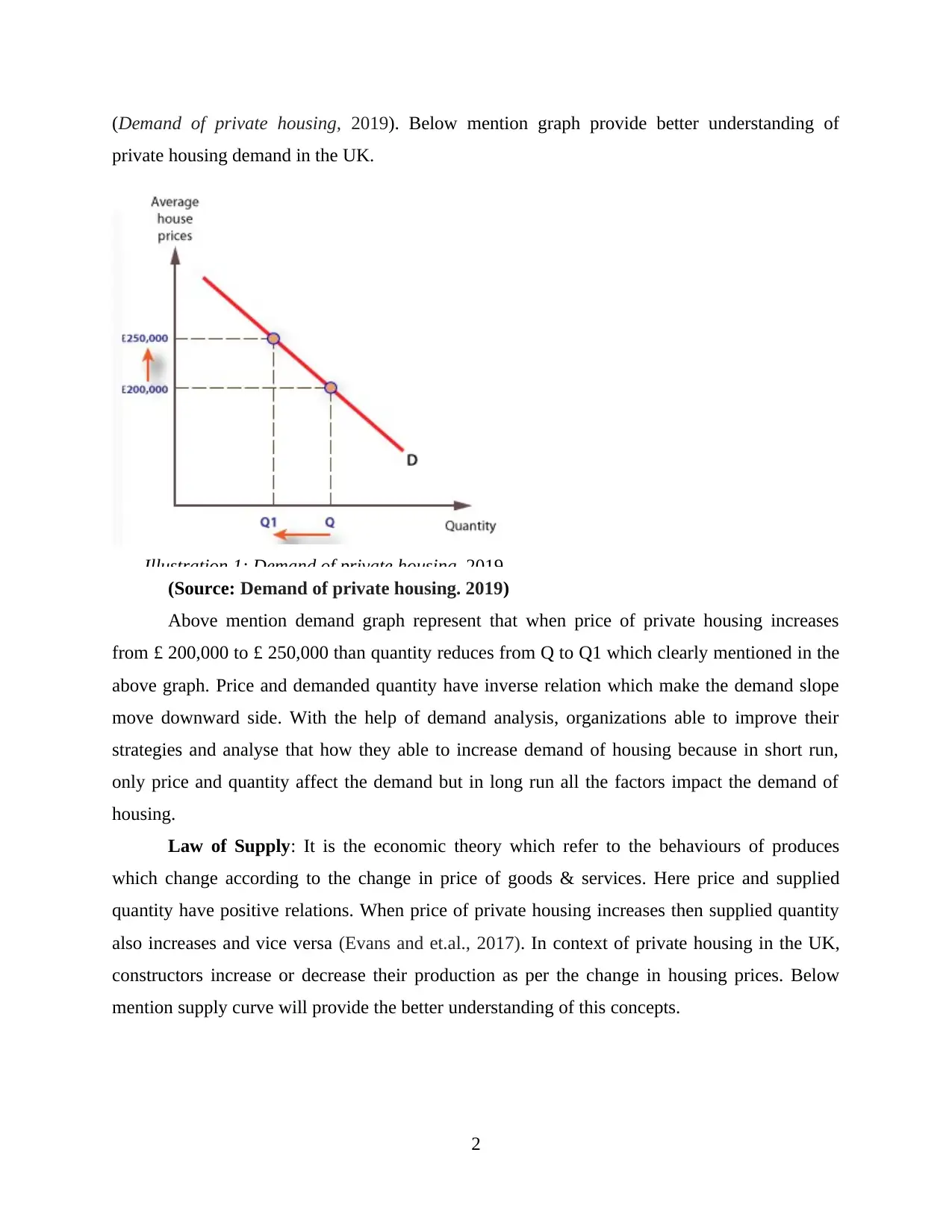
(Demand of private housing, 2019). Below mention graph provide better understanding of
private housing demand in the UK.
Illustration 1: Demand of private housing. 2019.
(Source: Demand of private housing. 2019)
Above mention demand graph represent that when price of private housing increases
from £ 200,000 to £ 250,000 than quantity reduces from Q to Q1 which clearly mentioned in the
above graph. Price and demanded quantity have inverse relation which make the demand slope
move downward side. With the help of demand analysis, organizations able to improve their
strategies and analyse that how they able to increase demand of housing because in short run,
only price and quantity affect the demand but in long run all the factors impact the demand of
housing.
Law of Supply: It is the economic theory which refer to the behaviours of produces
which change according to the change in price of goods & services. Here price and supplied
quantity have positive relations. When price of private housing increases then supplied quantity
also increases and vice versa (Evans and et.al., 2017). In context of private housing in the UK,
constructors increase or decrease their production as per the change in housing prices. Below
mention supply curve will provide the better understanding of this concepts.
2
private housing demand in the UK.
Illustration 1: Demand of private housing. 2019.
(Source: Demand of private housing. 2019)
Above mention demand graph represent that when price of private housing increases
from £ 200,000 to £ 250,000 than quantity reduces from Q to Q1 which clearly mentioned in the
above graph. Price and demanded quantity have inverse relation which make the demand slope
move downward side. With the help of demand analysis, organizations able to improve their
strategies and analyse that how they able to increase demand of housing because in short run,
only price and quantity affect the demand but in long run all the factors impact the demand of
housing.
Law of Supply: It is the economic theory which refer to the behaviours of produces
which change according to the change in price of goods & services. Here price and supplied
quantity have positive relations. When price of private housing increases then supplied quantity
also increases and vice versa (Evans and et.al., 2017). In context of private housing in the UK,
constructors increase or decrease their production as per the change in housing prices. Below
mention supply curve will provide the better understanding of this concepts.
2
Paraphrase This Document
Need a fresh take? Get an instant paraphrase of this document with our AI Paraphraser
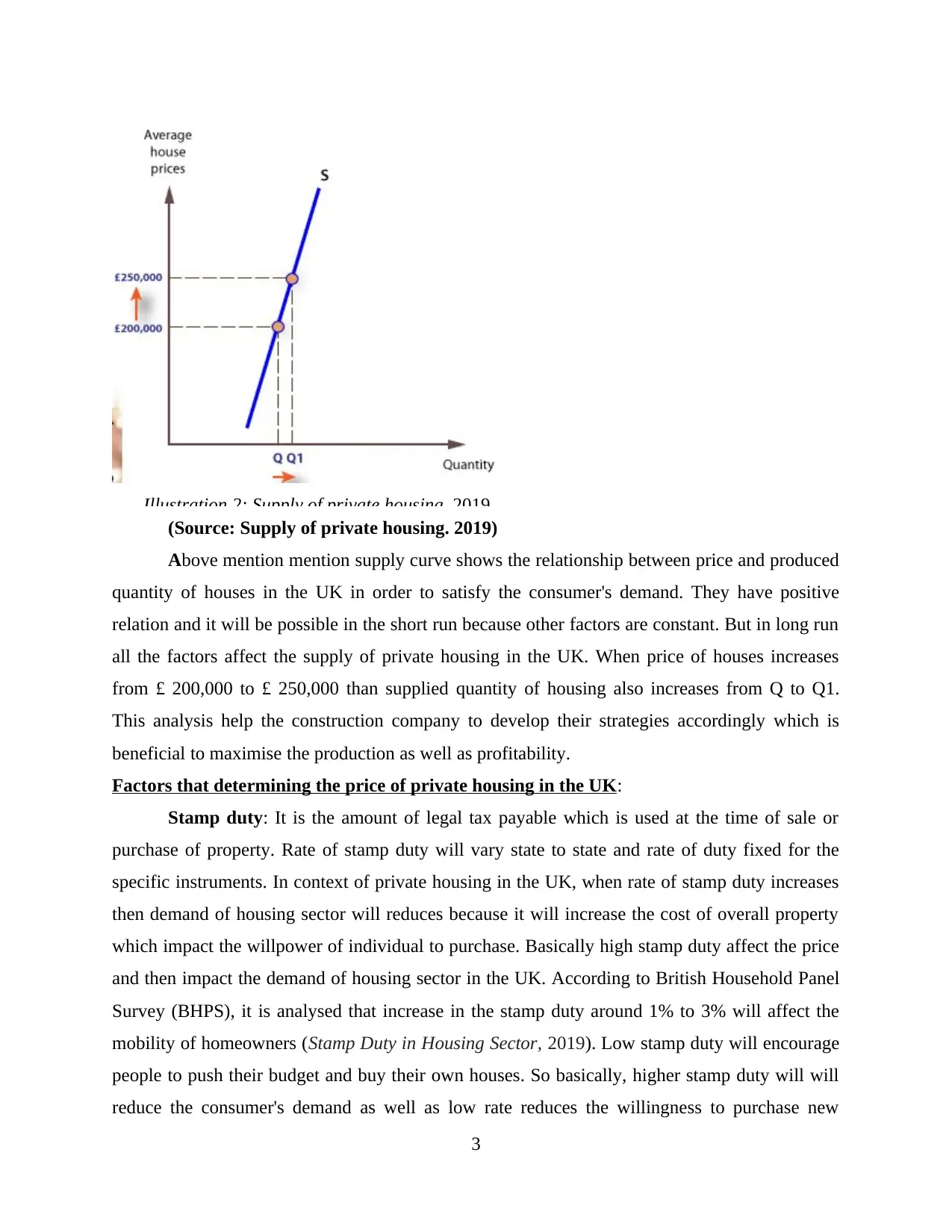
Illustration 2: Supply of private housing. 2019.
(Source: Supply of private housing. 2019)
Above mention mention supply curve shows the relationship between price and produced
quantity of houses in the UK in order to satisfy the consumer's demand. They have positive
relation and it will be possible in the short run because other factors are constant. But in long run
all the factors affect the supply of private housing in the UK. When price of houses increases
from £ 200,000 to £ 250,000 than supplied quantity of housing also increases from Q to Q1.
This analysis help the construction company to develop their strategies accordingly which is
beneficial to maximise the production as well as profitability.
Factors that determining the price of private housing in the UK:
Stamp duty: It is the amount of legal tax payable which is used at the time of sale or
purchase of property. Rate of stamp duty will vary state to state and rate of duty fixed for the
specific instruments. In context of private housing in the UK, when rate of stamp duty increases
then demand of housing sector will reduces because it will increase the cost of overall property
which impact the willpower of individual to purchase. Basically high stamp duty affect the price
and then impact the demand of housing sector in the UK. According to British Household Panel
Survey (BHPS), it is analysed that increase in the stamp duty around 1% to 3% will affect the
mobility of homeowners (Stamp Duty in Housing Sector, 2019). Low stamp duty will encourage
people to push their budget and buy their own houses. So basically, higher stamp duty will will
reduce the consumer's demand as well as low rate reduces the willingness to purchase new
3
(Source: Supply of private housing. 2019)
Above mention mention supply curve shows the relationship between price and produced
quantity of houses in the UK in order to satisfy the consumer's demand. They have positive
relation and it will be possible in the short run because other factors are constant. But in long run
all the factors affect the supply of private housing in the UK. When price of houses increases
from £ 200,000 to £ 250,000 than supplied quantity of housing also increases from Q to Q1.
This analysis help the construction company to develop their strategies accordingly which is
beneficial to maximise the production as well as profitability.
Factors that determining the price of private housing in the UK:
Stamp duty: It is the amount of legal tax payable which is used at the time of sale or
purchase of property. Rate of stamp duty will vary state to state and rate of duty fixed for the
specific instruments. In context of private housing in the UK, when rate of stamp duty increases
then demand of housing sector will reduces because it will increase the cost of overall property
which impact the willpower of individual to purchase. Basically high stamp duty affect the price
and then impact the demand of housing sector in the UK. According to British Household Panel
Survey (BHPS), it is analysed that increase in the stamp duty around 1% to 3% will affect the
mobility of homeowners (Stamp Duty in Housing Sector, 2019). Low stamp duty will encourage
people to push their budget and buy their own houses. So basically, higher stamp duty will will
reduce the consumer's demand as well as low rate reduces the willingness to purchase new
3
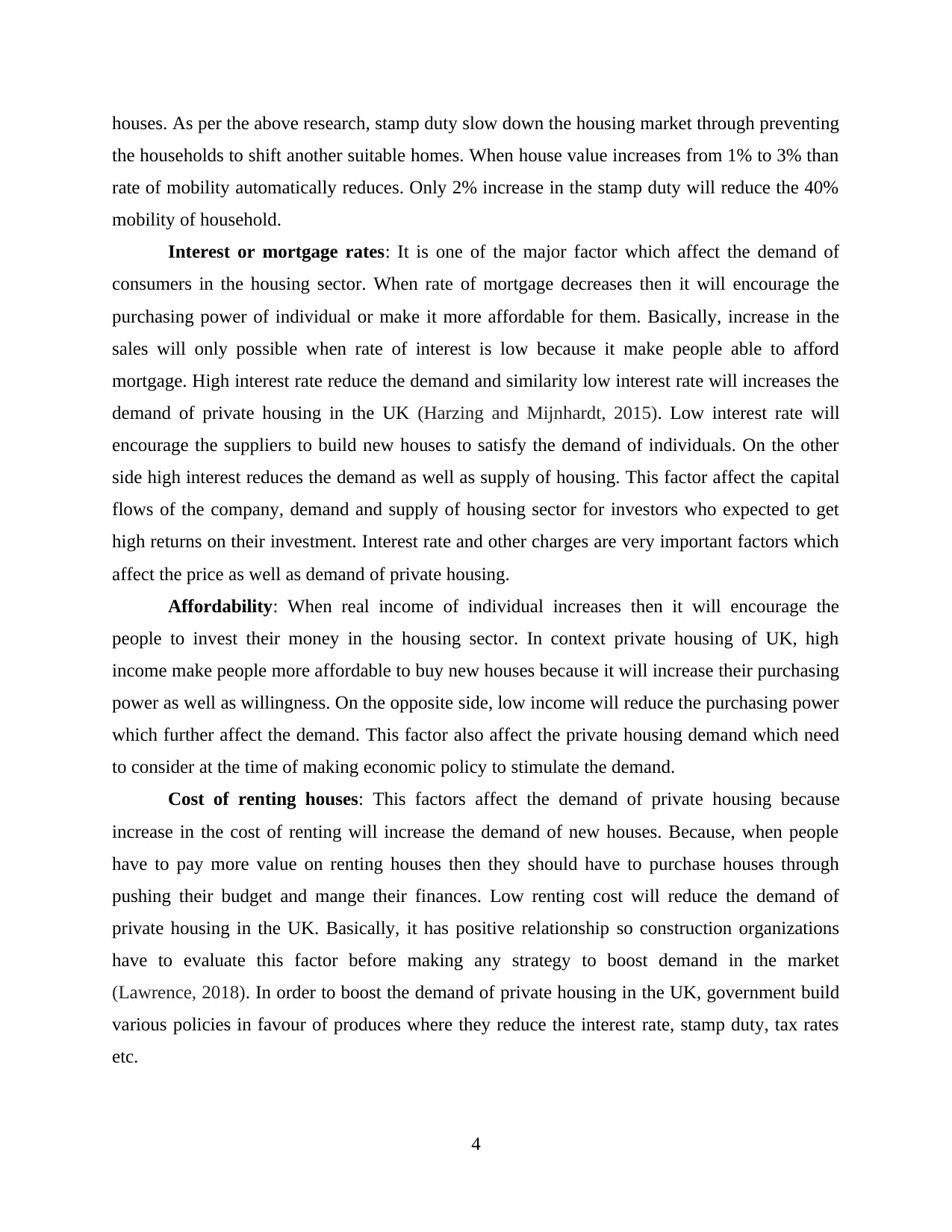
houses. As per the above research, stamp duty slow down the housing market through preventing
the households to shift another suitable homes. When house value increases from 1% to 3% than
rate of mobility automatically reduces. Only 2% increase in the stamp duty will reduce the 40%
mobility of household.
Interest or mortgage rates: It is one of the major factor which affect the demand of
consumers in the housing sector. When rate of mortgage decreases then it will encourage the
purchasing power of individual or make it more affordable for them. Basically, increase in the
sales will only possible when rate of interest is low because it make people able to afford
mortgage. High interest rate reduce the demand and similarity low interest rate will increases the
demand of private housing in the UK (Harzing and Mijnhardt, 2015). Low interest rate will
encourage the suppliers to build new houses to satisfy the demand of individuals. On the other
side high interest reduces the demand as well as supply of housing. This factor affect the capital
flows of the company, demand and supply of housing sector for investors who expected to get
high returns on their investment. Interest rate and other charges are very important factors which
affect the price as well as demand of private housing.
Affordability: When real income of individual increases then it will encourage the
people to invest their money in the housing sector. In context private housing of UK, high
income make people more affordable to buy new houses because it will increase their purchasing
power as well as willingness. On the opposite side, low income will reduce the purchasing power
which further affect the demand. This factor also affect the private housing demand which need
to consider at the time of making economic policy to stimulate the demand.
Cost of renting houses: This factors affect the demand of private housing because
increase in the cost of renting will increase the demand of new houses. Because, when people
have to pay more value on renting houses then they should have to purchase houses through
pushing their budget and mange their finances. Low renting cost will reduce the demand of
private housing in the UK. Basically, it has positive relationship so construction organizations
have to evaluate this factor before making any strategy to boost demand in the market
(Lawrence, 2018). In order to boost the demand of private housing in the UK, government build
various policies in favour of produces where they reduce the interest rate, stamp duty, tax rates
etc.
4
the households to shift another suitable homes. When house value increases from 1% to 3% than
rate of mobility automatically reduces. Only 2% increase in the stamp duty will reduce the 40%
mobility of household.
Interest or mortgage rates: It is one of the major factor which affect the demand of
consumers in the housing sector. When rate of mortgage decreases then it will encourage the
purchasing power of individual or make it more affordable for them. Basically, increase in the
sales will only possible when rate of interest is low because it make people able to afford
mortgage. High interest rate reduce the demand and similarity low interest rate will increases the
demand of private housing in the UK (Harzing and Mijnhardt, 2015). Low interest rate will
encourage the suppliers to build new houses to satisfy the demand of individuals. On the other
side high interest reduces the demand as well as supply of housing. This factor affect the capital
flows of the company, demand and supply of housing sector for investors who expected to get
high returns on their investment. Interest rate and other charges are very important factors which
affect the price as well as demand of private housing.
Affordability: When real income of individual increases then it will encourage the
people to invest their money in the housing sector. In context private housing of UK, high
income make people more affordable to buy new houses because it will increase their purchasing
power as well as willingness. On the opposite side, low income will reduce the purchasing power
which further affect the demand. This factor also affect the private housing demand which need
to consider at the time of making economic policy to stimulate the demand.
Cost of renting houses: This factors affect the demand of private housing because
increase in the cost of renting will increase the demand of new houses. Because, when people
have to pay more value on renting houses then they should have to purchase houses through
pushing their budget and mange their finances. Low renting cost will reduce the demand of
private housing in the UK. Basically, it has positive relationship so construction organizations
have to evaluate this factor before making any strategy to boost demand in the market
(Lawrence, 2018). In order to boost the demand of private housing in the UK, government build
various policies in favour of produces where they reduce the interest rate, stamp duty, tax rates
etc.
4
⊘ This is a preview!⊘
Do you want full access?
Subscribe today to unlock all pages.

Trusted by 1+ million students worldwide
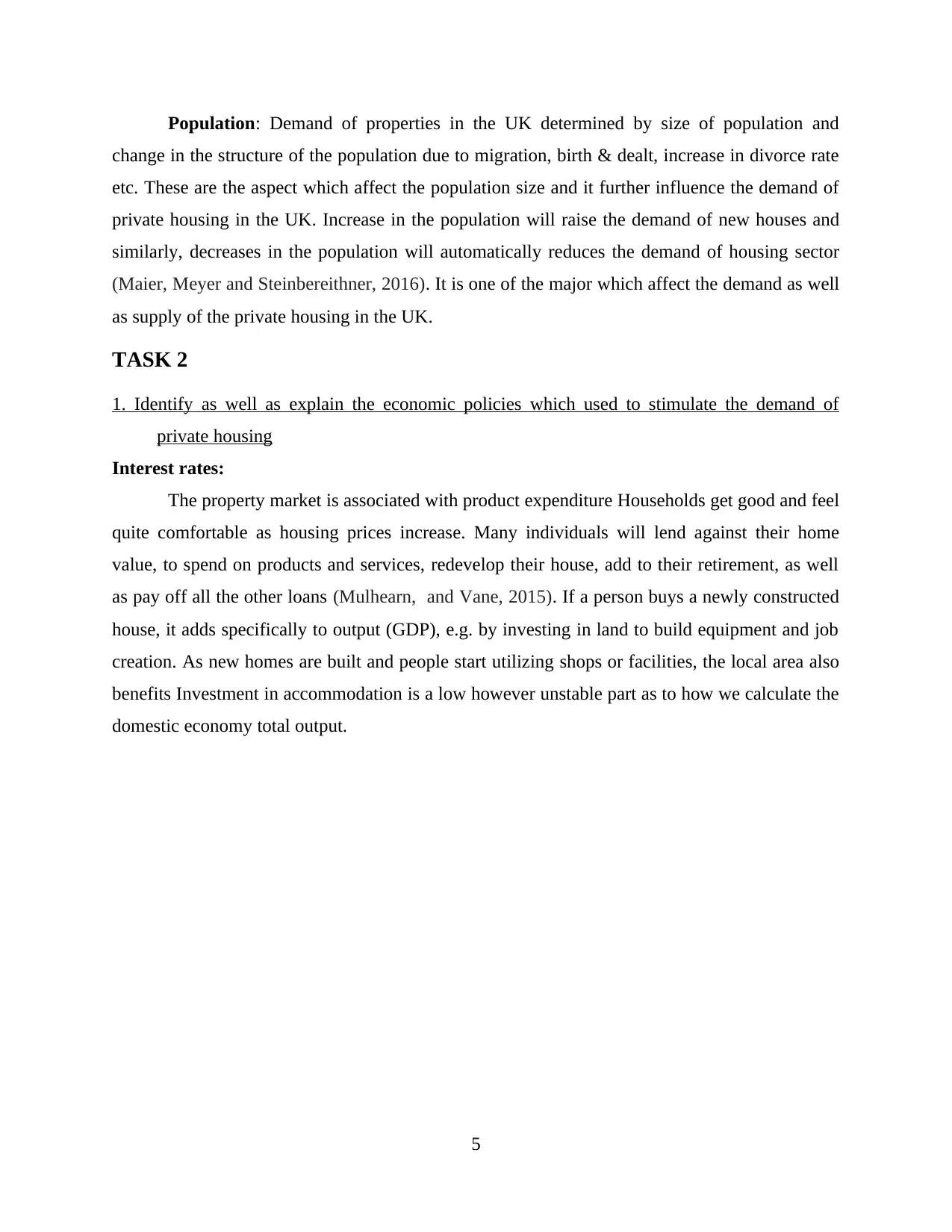
Population: Demand of properties in the UK determined by size of population and
change in the structure of the population due to migration, birth & dealt, increase in divorce rate
etc. These are the aspect which affect the population size and it further influence the demand of
private housing in the UK. Increase in the population will raise the demand of new houses and
similarly, decreases in the population will automatically reduces the demand of housing sector
(Maier, Meyer and Steinbereithner, 2016). It is one of the major which affect the demand as well
as supply of the private housing in the UK.
TASK 2
1. Identify as well as explain the economic policies which used to stimulate the demand of
private housing
Interest rates:
The property market is associated with product expenditure Households get good and feel
quite comfortable as housing prices increase. Many individuals will lend against their home
value, to spend on products and services, redevelop their house, add to their retirement, as well
as pay off all the other loans (Mulhearn, and Vane, 2015). If a person buys a newly constructed
house, it adds specifically to output (GDP), e.g. by investing in land to build equipment and job
creation. As new homes are built and people start utilizing shops or facilities, the local area also
benefits Investment in accommodation is a low however unstable part as to how we calculate the
domestic economy total output.
5
change in the structure of the population due to migration, birth & dealt, increase in divorce rate
etc. These are the aspect which affect the population size and it further influence the demand of
private housing in the UK. Increase in the population will raise the demand of new houses and
similarly, decreases in the population will automatically reduces the demand of housing sector
(Maier, Meyer and Steinbereithner, 2016). It is one of the major which affect the demand as well
as supply of the private housing in the UK.
TASK 2
1. Identify as well as explain the economic policies which used to stimulate the demand of
private housing
Interest rates:
The property market is associated with product expenditure Households get good and feel
quite comfortable as housing prices increase. Many individuals will lend against their home
value, to spend on products and services, redevelop their house, add to their retirement, as well
as pay off all the other loans (Mulhearn, and Vane, 2015). If a person buys a newly constructed
house, it adds specifically to output (GDP), e.g. by investing in land to build equipment and job
creation. As new homes are built and people start utilizing shops or facilities, the local area also
benefits Investment in accommodation is a low however unstable part as to how we calculate the
domestic economy total output.
5
Paraphrase This Document
Need a fresh take? Get an instant paraphrase of this document with our AI Paraphraser
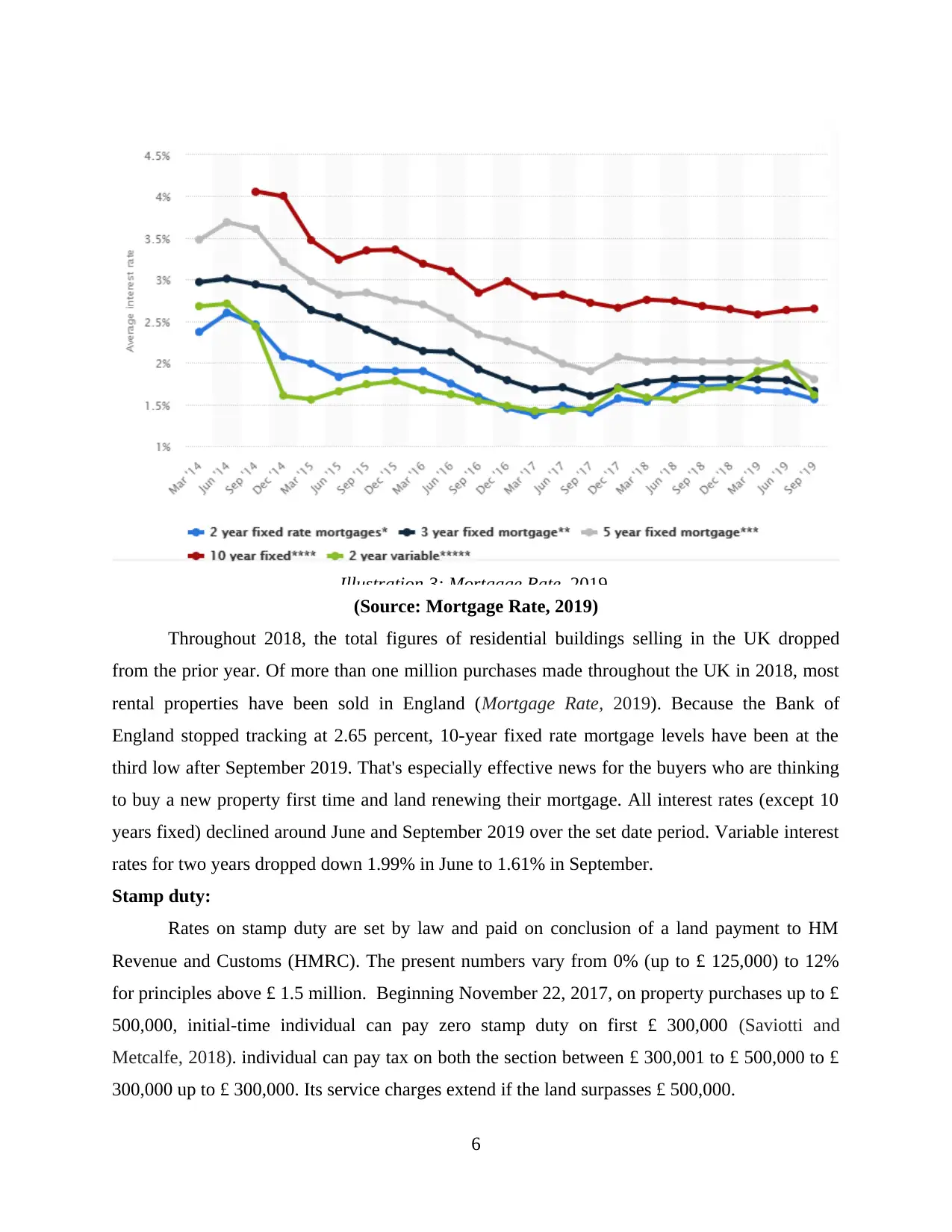
Illustration 3: Mortgage Rate, 2019.
(Source: Mortgage Rate, 2019)
Throughout 2018, the total figures of residential buildings selling in the UK dropped
from the prior year. Of more than one million purchases made throughout the UK in 2018, most
rental properties have been sold in England (Mortgage Rate, 2019). Because the Bank of
England stopped tracking at 2.65 percent, 10-year fixed rate mortgage levels have been at the
third low after September 2019. That's especially effective news for the buyers who are thinking
to buy a new property first time and land renewing their mortgage. All interest rates (except 10
years fixed) declined around June and September 2019 over the set date period. Variable interest
rates for two years dropped down 1.99% in June to 1.61% in September.
Stamp duty:
Rates on stamp duty are set by law and paid on conclusion of a land payment to HM
Revenue and Customs (HMRC). The present numbers vary from 0% (up to £ 125,000) to 12%
for principles above £ 1.5 million. Beginning November 22, 2017, on property purchases up to £
500,000, initial-time individual can pay zero stamp duty on first £ 300,000 (Saviotti and
Metcalfe, 2018). individual can pay tax on both the section between £ 300,001 to £ 500,000 to £
300,000 up to £ 300,000. Its service charges extend if the land surpasses £ 500,000.
6
(Source: Mortgage Rate, 2019)
Throughout 2018, the total figures of residential buildings selling in the UK dropped
from the prior year. Of more than one million purchases made throughout the UK in 2018, most
rental properties have been sold in England (Mortgage Rate, 2019). Because the Bank of
England stopped tracking at 2.65 percent, 10-year fixed rate mortgage levels have been at the
third low after September 2019. That's especially effective news for the buyers who are thinking
to buy a new property first time and land renewing their mortgage. All interest rates (except 10
years fixed) declined around June and September 2019 over the set date period. Variable interest
rates for two years dropped down 1.99% in June to 1.61% in September.
Stamp duty:
Rates on stamp duty are set by law and paid on conclusion of a land payment to HM
Revenue and Customs (HMRC). The present numbers vary from 0% (up to £ 125,000) to 12%
for principles above £ 1.5 million. Beginning November 22, 2017, on property purchases up to £
500,000, initial-time individual can pay zero stamp duty on first £ 300,000 (Saviotti and
Metcalfe, 2018). individual can pay tax on both the section between £ 300,001 to £ 500,000 to £
300,000 up to £ 300,000. Its service charges extend if the land surpasses £ 500,000.
6
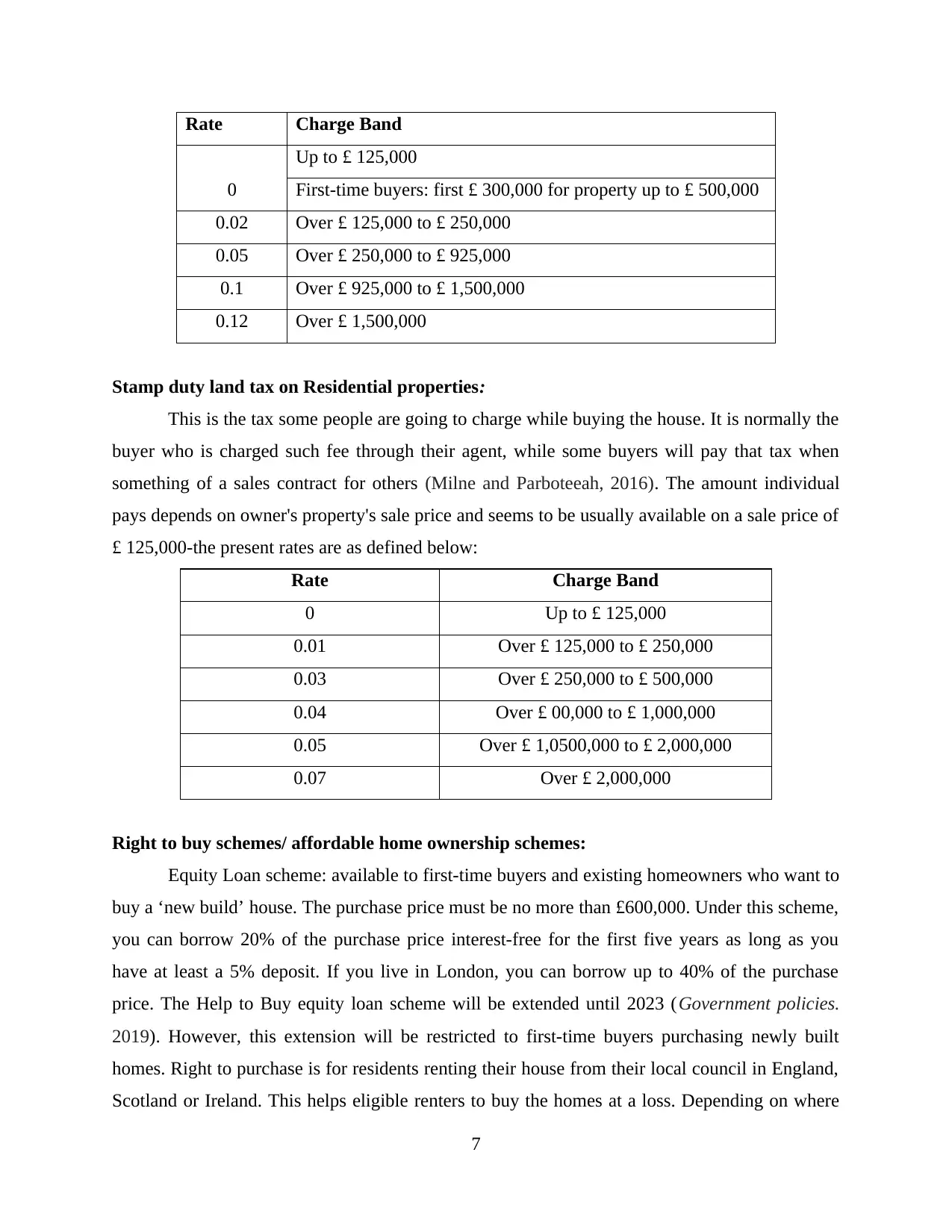
Rate Charge Band
0
Up to £ 125,000
First-time buyers: first £ 300,000 for property up to £ 500,000
0.02 Over £ 125,000 to £ 250,000
0.05 Over £ 250,000 to £ 925,000
0.1 Over £ 925,000 to £ 1,500,000
0.12 Over £ 1,500,000
Stamp duty land tax on Residential properties:
This is the tax some people are going to charge while buying the house. It is normally the
buyer who is charged such fee through their agent, while some buyers will pay that tax when
something of a sales contract for others (Milne and Parboteeah, 2016). The amount individual
pays depends on owner's property's sale price and seems to be usually available on a sale price of
£ 125,000-the present rates are as defined below:
Rate Charge Band
0 Up to £ 125,000
0.01 Over £ 125,000 to £ 250,000
0.03 Over £ 250,000 to £ 500,000
0.04 Over £ 00,000 to £ 1,000,000
0.05 Over £ 1,0500,000 to £ 2,000,000
0.07 Over £ 2,000,000
Right to buy schemes/ affordable home ownership schemes:
Equity Loan scheme: available to first-time buyers and existing homeowners who want to
buy a ‘new build’ house. The purchase price must be no more than £600,000. Under this scheme,
you can borrow 20% of the purchase price interest-free for the first five years as long as you
have at least a 5% deposit. If you live in London, you can borrow up to 40% of the purchase
price. The Help to Buy equity loan scheme will be extended until 2023 (Government policies.
2019). However, this extension will be restricted to first-time buyers purchasing newly built
homes. Right to purchase is for residents renting their house from their local council in England,
Scotland or Ireland. This helps eligible renters to buy the homes at a loss. Depending on where
7
0
Up to £ 125,000
First-time buyers: first £ 300,000 for property up to £ 500,000
0.02 Over £ 125,000 to £ 250,000
0.05 Over £ 250,000 to £ 925,000
0.1 Over £ 925,000 to £ 1,500,000
0.12 Over £ 1,500,000
Stamp duty land tax on Residential properties:
This is the tax some people are going to charge while buying the house. It is normally the
buyer who is charged such fee through their agent, while some buyers will pay that tax when
something of a sales contract for others (Milne and Parboteeah, 2016). The amount individual
pays depends on owner's property's sale price and seems to be usually available on a sale price of
£ 125,000-the present rates are as defined below:
Rate Charge Band
0 Up to £ 125,000
0.01 Over £ 125,000 to £ 250,000
0.03 Over £ 250,000 to £ 500,000
0.04 Over £ 00,000 to £ 1,000,000
0.05 Over £ 1,0500,000 to £ 2,000,000
0.07 Over £ 2,000,000
Right to buy schemes/ affordable home ownership schemes:
Equity Loan scheme: available to first-time buyers and existing homeowners who want to
buy a ‘new build’ house. The purchase price must be no more than £600,000. Under this scheme,
you can borrow 20% of the purchase price interest-free for the first five years as long as you
have at least a 5% deposit. If you live in London, you can borrow up to 40% of the purchase
price. The Help to Buy equity loan scheme will be extended until 2023 (Government policies.
2019). However, this extension will be restricted to first-time buyers purchasing newly built
homes. Right to purchase is for residents renting their house from their local council in England,
Scotland or Ireland. This helps eligible renters to buy the homes at a loss. Depending on where
7
⊘ This is a preview!⊘
Do you want full access?
Subscribe today to unlock all pages.

Trusted by 1+ million students worldwide
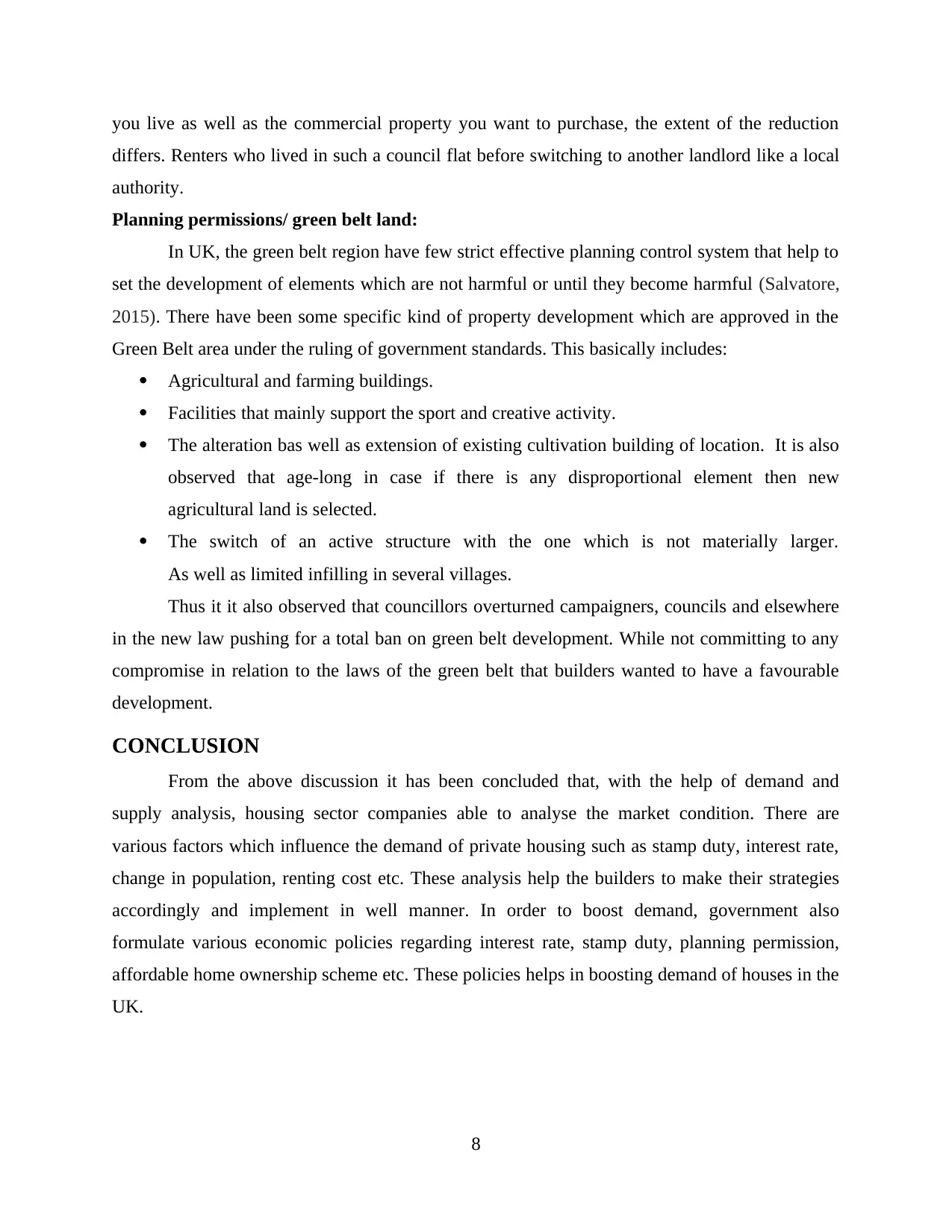
you live as well as the commercial property you want to purchase, the extent of the reduction
differs. Renters who lived in such a council flat before switching to another landlord like a local
authority.
Planning permissions/ green belt land:
In UK, the green belt region have few strict effective planning control system that help to
set the development of elements which are not harmful or until they become harmful (Salvatore,
2015). There have been some specific kind of property development which are approved in the
Green Belt area under the ruling of government standards. This basically includes:
Agricultural and farming buildings.
Facilities that mainly support the sport and creative activity.
The alteration bas well as extension of existing cultivation building of location. It is also
observed that age-long in case if there is any disproportional element then new
agricultural land is selected.
The switch of an active structure with the one which is not materially larger.
As well as limited infilling in several villages.
Thus it it also observed that councillors overturned campaigners, councils and elsewhere
in the new law pushing for a total ban on green belt development. While not committing to any
compromise in relation to the laws of the green belt that builders wanted to have a favourable
development.
CONCLUSION
From the above discussion it has been concluded that, with the help of demand and
supply analysis, housing sector companies able to analyse the market condition. There are
various factors which influence the demand of private housing such as stamp duty, interest rate,
change in population, renting cost etc. These analysis help the builders to make their strategies
accordingly and implement in well manner. In order to boost demand, government also
formulate various economic policies regarding interest rate, stamp duty, planning permission,
affordable home ownership scheme etc. These policies helps in boosting demand of houses in the
UK.
8
differs. Renters who lived in such a council flat before switching to another landlord like a local
authority.
Planning permissions/ green belt land:
In UK, the green belt region have few strict effective planning control system that help to
set the development of elements which are not harmful or until they become harmful (Salvatore,
2015). There have been some specific kind of property development which are approved in the
Green Belt area under the ruling of government standards. This basically includes:
Agricultural and farming buildings.
Facilities that mainly support the sport and creative activity.
The alteration bas well as extension of existing cultivation building of location. It is also
observed that age-long in case if there is any disproportional element then new
agricultural land is selected.
The switch of an active structure with the one which is not materially larger.
As well as limited infilling in several villages.
Thus it it also observed that councillors overturned campaigners, councils and elsewhere
in the new law pushing for a total ban on green belt development. While not committing to any
compromise in relation to the laws of the green belt that builders wanted to have a favourable
development.
CONCLUSION
From the above discussion it has been concluded that, with the help of demand and
supply analysis, housing sector companies able to analyse the market condition. There are
various factors which influence the demand of private housing such as stamp duty, interest rate,
change in population, renting cost etc. These analysis help the builders to make their strategies
accordingly and implement in well manner. In order to boost demand, government also
formulate various economic policies regarding interest rate, stamp duty, planning permission,
affordable home ownership scheme etc. These policies helps in boosting demand of houses in the
UK.
8
Paraphrase This Document
Need a fresh take? Get an instant paraphrase of this document with our AI Paraphraser
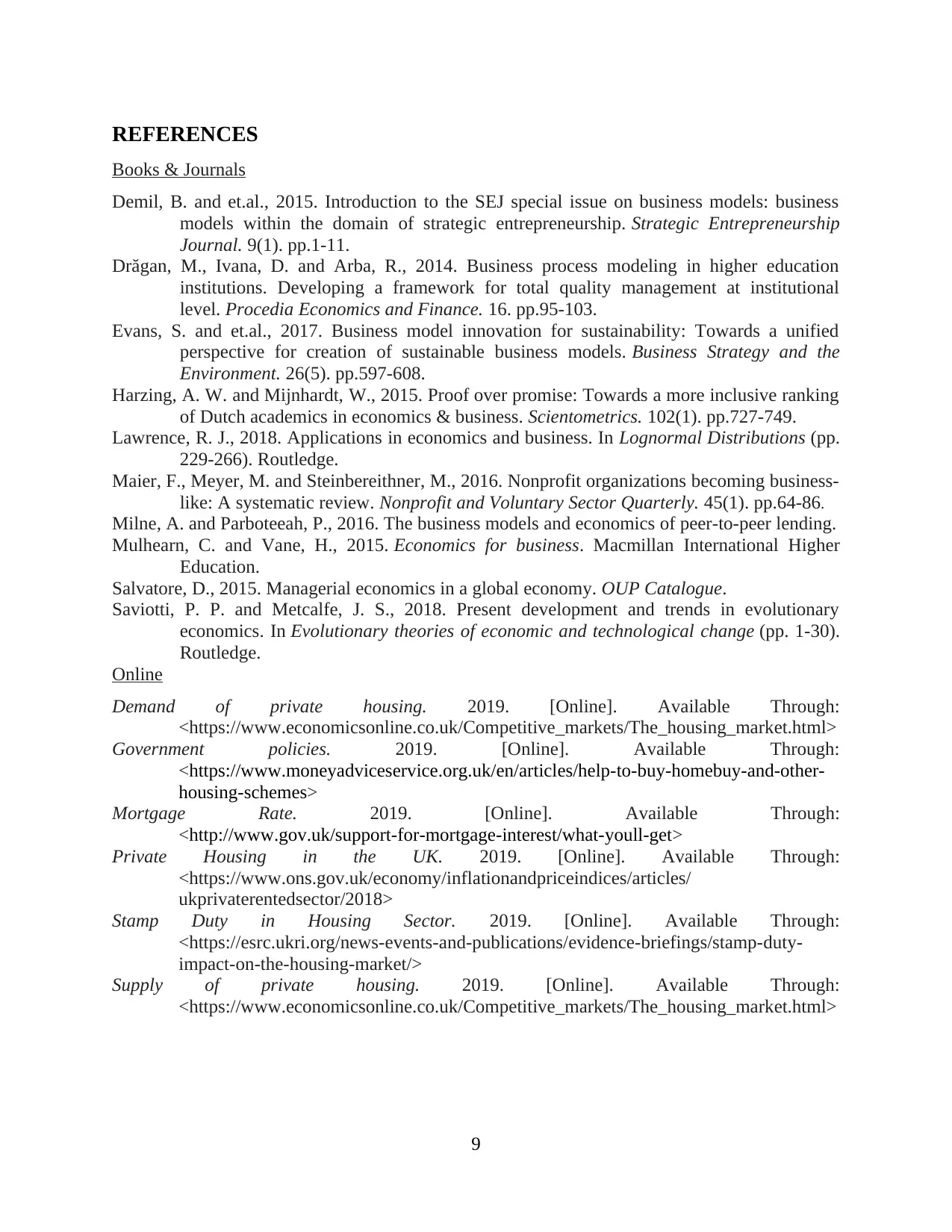
REFERENCES
Books & Journals
Demil, B. and et.al., 2015. Introduction to the SEJ special issue on business models: business
models within the domain of strategic entrepreneurship. Strategic Entrepreneurship
Journal. 9(1). pp.1-11.
Drăgan, M., Ivana, D. and Arba, R., 2014. Business process modeling in higher education
institutions. Developing a framework for total quality management at institutional
level. Procedia Economics and Finance. 16. pp.95-103.
Evans, S. and et.al., 2017. Business model innovation for sustainability: Towards a unified
perspective for creation of sustainable business models. Business Strategy and the
Environment. 26(5). pp.597-608.
Harzing, A. W. and Mijnhardt, W., 2015. Proof over promise: Towards a more inclusive ranking
of Dutch academics in economics & business. Scientometrics. 102(1). pp.727-749.
Lawrence, R. J., 2018. Applications in economics and business. In Lognormal Distributions (pp.
229-266). Routledge.
Maier, F., Meyer, M. and Steinbereithner, M., 2016. Nonprofit organizations becoming business-
like: A systematic review. Nonprofit and Voluntary Sector Quarterly. 45(1). pp.64-86.
Milne, A. and Parboteeah, P., 2016. The business models and economics of peer-to-peer lending.
Mulhearn, C. and Vane, H., 2015. Economics for business. Macmillan International Higher
Education.
Salvatore, D., 2015. Managerial economics in a global economy. OUP Catalogue.
Saviotti, P. P. and Metcalfe, J. S., 2018. Present development and trends in evolutionary
economics. In Evolutionary theories of economic and technological change (pp. 1-30).
Routledge.
Online
Demand of private housing. 2019. [Online]. Available Through:
<https://www.economicsonline.co.uk/Competitive_markets/The_housing_market.html>
Government policies. 2019. [Online]. Available Through:
<https://www.moneyadviceservice.org.uk/en/articles/help-to-buy-homebuy-and-other-
housing-schemes>
Mortgage Rate. 2019. [Online]. Available Through:
<http://www.gov.uk/support-for-mortgage-interest/what-youll-get>
Private Housing in the UK. 2019. [Online]. Available Through:
<https://www.ons.gov.uk/economy/inflationandpriceindices/articles/
ukprivaterentedsector/2018>
Stamp Duty in Housing Sector. 2019. [Online]. Available Through:
<https://esrc.ukri.org/news-events-and-publications/evidence-briefings/stamp-duty-
impact-on-the-housing-market/>
Supply of private housing. 2019. [Online]. Available Through:
<https://www.economicsonline.co.uk/Competitive_markets/The_housing_market.html>
9
Books & Journals
Demil, B. and et.al., 2015. Introduction to the SEJ special issue on business models: business
models within the domain of strategic entrepreneurship. Strategic Entrepreneurship
Journal. 9(1). pp.1-11.
Drăgan, M., Ivana, D. and Arba, R., 2014. Business process modeling in higher education
institutions. Developing a framework for total quality management at institutional
level. Procedia Economics and Finance. 16. pp.95-103.
Evans, S. and et.al., 2017. Business model innovation for sustainability: Towards a unified
perspective for creation of sustainable business models. Business Strategy and the
Environment. 26(5). pp.597-608.
Harzing, A. W. and Mijnhardt, W., 2015. Proof over promise: Towards a more inclusive ranking
of Dutch academics in economics & business. Scientometrics. 102(1). pp.727-749.
Lawrence, R. J., 2018. Applications in economics and business. In Lognormal Distributions (pp.
229-266). Routledge.
Maier, F., Meyer, M. and Steinbereithner, M., 2016. Nonprofit organizations becoming business-
like: A systematic review. Nonprofit and Voluntary Sector Quarterly. 45(1). pp.64-86.
Milne, A. and Parboteeah, P., 2016. The business models and economics of peer-to-peer lending.
Mulhearn, C. and Vane, H., 2015. Economics for business. Macmillan International Higher
Education.
Salvatore, D., 2015. Managerial economics in a global economy. OUP Catalogue.
Saviotti, P. P. and Metcalfe, J. S., 2018. Present development and trends in evolutionary
economics. In Evolutionary theories of economic and technological change (pp. 1-30).
Routledge.
Online
Demand of private housing. 2019. [Online]. Available Through:
<https://www.economicsonline.co.uk/Competitive_markets/The_housing_market.html>
Government policies. 2019. [Online]. Available Through:
<https://www.moneyadviceservice.org.uk/en/articles/help-to-buy-homebuy-and-other-
housing-schemes>
Mortgage Rate. 2019. [Online]. Available Through:
<http://www.gov.uk/support-for-mortgage-interest/what-youll-get>
Private Housing in the UK. 2019. [Online]. Available Through:
<https://www.ons.gov.uk/economy/inflationandpriceindices/articles/
ukprivaterentedsector/2018>
Stamp Duty in Housing Sector. 2019. [Online]. Available Through:
<https://esrc.ukri.org/news-events-and-publications/evidence-briefings/stamp-duty-
impact-on-the-housing-market/>
Supply of private housing. 2019. [Online]. Available Through:
<https://www.economicsonline.co.uk/Competitive_markets/The_housing_market.html>
9
1 out of 11
Related Documents
Your All-in-One AI-Powered Toolkit for Academic Success.
+13062052269
info@desklib.com
Available 24*7 on WhatsApp / Email
![[object Object]](/_next/static/media/star-bottom.7253800d.svg)
Unlock your academic potential
Copyright © 2020–2025 A2Z Services. All Rights Reserved. Developed and managed by ZUCOL.





